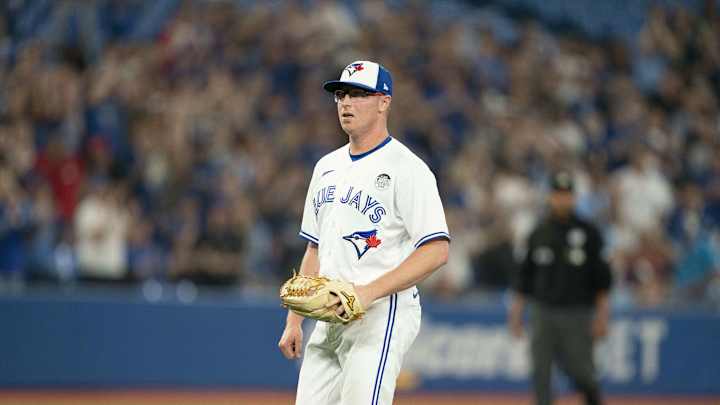Blue Jays Notebook: Thornton’s Quiet Success, Pearson's Rehab, and Berrios’ Recovery

Trent Thornton gave the Blue Jays a chance on Tuesday.
Trotting in from the Blue Jays bullpen tasked with soaking up some innings, Thornton pitched 2.2 frames, retiring all but one of the batters he faced on just 27 pitches. Toronto ultimately came up short on the comeback attempt, as Thornton kept the Oriole bats quiet, but the righty did his job.
"I told him keep it going," Montoyo said after the game. "He's doing great and he's throwing strikes with all his pitches. He gave us a chance today."
Effective relief from Thornton is becoming more commonplace in Jays games of late, as his ERA is down to 2.59 and he's allowed just one run in his last seven outings (10.2 IP). In Tuesday's outing, Thornton tossed 14 sliders on his 27 deliveries, and it's that fresh pitch that's been crucial for his quiet 2022 success.
Below, find notes on Thornton's new slider, Nate Pearson's ongoing rehab, and some routine changes that helped José Berríos return to expected form:
Trent Thornton Carving Out A Role
Last year, Trent Thornton's slider was his worst pitch—opponents hit .333 off it.
The lack of slide-piece success didn't really make sense though, as Thornton never struggled to spin his pitches. Looking to find something that worked this year, Toronto pitching coordinator David Howell suggested some grip changes that Thornton tried out in late spring training.
The day he learned the new grip, Thornton tossed the new slider immediately into game action against the Yankees. The results were instant, inducing a shallow pop-out to Giancarlo Stanton on his second ever in-game attempt with the new pitch. He finished the outing with 1.2 scoreless, striking out Aaron Hicks, Gleyber Torres, and D.J. LeMahieu.
That slide-piece success has carried into the season, with Thornton throwing it more than ever (37%) and holding batters to just a .150 batting average against on it. It's still a work-in-progress pitch, Thornton says, building toward consistency in the shape and velocity on the slider, but his confidence in the pitch is pretty high and it's made his whole repertoire better.
When Will We See Nate Pearson With the Blue Jays?
Nate Pearson pitched his fourth rehab outing of the season on Tuesday night, delivering two innings with one earned run and four strikeouts. Montoyo said his report from the minors indicated it was Pearson's best outing yet, and the righty looked sharp.
Across his four minors outings this year, Pearson has pitched 7.2 innings (2 IP in each of the last three outings), working exclusively out of the 'pen. He's allowed three earned runs, walked three, and struck out 10.
Hyun Jin Ryu's surgery doesn't impact how the club plans to use Pearson in the short term, GM Ross Atkins said, but he could play himself into a rotation option.
"That is a very real option, maybe more a creative route," Atkins said. "We'll see, we'd rather just go one outing at a time with Nate."
The team is hoping to reduce the amount of time between Pearson's outings and up the innings from two to three, moving forward. Though only 10 days remain on Pearson's rehab time with the Bisons, he may not immediately join the Jays after that and can be optioned to the minors to keep building up and working in Buffalo.
"He's gotta keep pitching good," Montoyo said. "You're not just gonna bring him here because you're throwing 98, you gotta pitch good. And yesterday he was good."
Jose Berríos Tweaks Routine Between Starts
After José Berríos allowed six runs in 2.1 innings in Anaheim, experiencing "dead arm" that zapped his velocity and effectiveness, the starter and the Blue Jays decided to make some tweaks to his routine between starts.
Adjustments to his throwing program and weighted ball program, which are natural for many pitchers throughout a season, paid off immediately, with 15 innings of three-run ball in his two starts since.
Berríos' sinker had great movement in the last two outings, his velocity ticked back up, and he seems to "be refreshed," Toronto pitching coach Pete Walker told Inside the Blue Jays.
"He's coming out throwing harder than he has all season," Walker said after his last start. "So it kind of worked."
Every Blue Jays pitcher wears what is called a Catapult during training and pitching, essentially a vest that tracks pitch quantity, intensity, and other data to aid injury prevention. Alongside other tools to track workload and fatigue levels, the data helps the team identify red flags for players to prevent major injuries or correct routines between games to get the most out of the players.
"We're definitely utilizing it to the fullest," Walker said "And you know, when we see a red flag, we address it."

Mitch Bannon is a baseball reporter for Sports Illustrated covering the Toronto Blue Jays and their minor league affiliates.Twitter: @MitchBannon